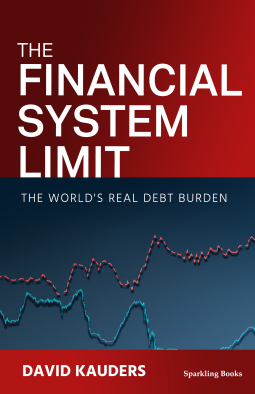
The Financial System Limit
The world's real debt burden
by David Kauders
This title was previously available on NetGalley and is now archived.
Send NetGalley books directly to your Kindle or Kindle app
1
To read on a Kindle or Kindle app, please add kindle@netgalley.com as an approved email address to receive files in your Amazon account. Click here for step-by-step instructions.
2
Also find your Kindle email address within your Amazon account, and enter it here.
Pub Date 23 Aug 2021 | Archive Date 7 Sep 2021
Sparkling Books Ltd | Sparkling Books
Talking about this book? Use #LimitFS #NetGalley. More hashtag tips!
Description
"Neither Keynes nor his disciples foresaw the eventual creation of unaffordable debt nearly a century later."
Why were economies sluggish before the pandemic arrived? Why have interest rates paid by businesses and households been rising even though deposit rates are nil? Does the policy of bailing out economies, now followed by most governments and central banks, bring any dangers?
In The Financial System Limit, British investment manager David Kauders FRSA puts forward three radical theories which together provide the answers to these questions. These theories show that Keynesian economics has gradually turned from a benefit to society, into a damaging scheme. Other economic policies are also not addressing the fundamental problem, which is the world’s inability to afford private sector debts already created.
The author challenges the existing academic and political consensus about how economies should be managed. The old arguments about sound money versus stimulus, as well as contemporary arguments that governments controlling their own currency can create as much credit as they wish, are fundamentally inappropriate to a world in which private sector debt far exceeds public debt and carries a higher, rising, interest cost.
Whether you are a concerned individual, an academic, politician, banker or even a policymaker, read about a different view of the current financial orthodoxies, one that will provoke serious debate and even action.
“Radical thinkers might have a point” was how the Financial Times described David Kauders’ first book The Greatest Crash: How contradictory policies are sinking the global economy. This new book offers further original thought.
A Note From the Publisher
The UK edition is 9781907230790, hardcover, to be published in August. The subtitle will be "Britain's real debt burden". This edition has a postscript: Britain's real debt burden and the extent will be 160 pages.
There is a paperback edition 9781907230783 available in other markets. Please visit sparklingbooks.biz for details.
The e-book is one edition globally, 9781907230776, available now.
Advance Praise
"One of the most fascinating books I've ever read" - NetGalley reviewer
"The author provides a historical view of how we reached the point where the level of global debt is unsustainable and now compounded by a global pandemic. The book is understandable by those without a deep financial background.
"Kauders, who has decades of experience as an investment manager makes the case for the difficult situation we, as global citizens, are confronted with." - Librarything reviewer
"The book pleas to measure interest cost on total debt in relation to economic output. A deep recession and consequential financial upset were inevitable in a world that could not resolve the conflict between stimulus and austerity, a world that remained addicted to debt, a world that refused to admit the limit to the growth of debt caused by the cost of servicing it. That's what David Kauders wants to highlight." - Hank van der Klis, Netherlands
"Credit to Kauders for sharing his observations, experience and proposing solutions." - Librarything reviewer
Marketing Plan
There are three print editions, see notes
Australia and New Zealand edition has been published (9781907230783). This paperback edition is available outside US and UK
US edition has been published, 9781907230769
Available Editions
| ISBN | 9781907230790 |
| PRICE | £17.95 (GBP) |
Average rating from 5 members
Featured Reviews
 Flo J, Educator
Flo J, Educator
One of the most fascinating book I've ever read ! It is like a travel in time, the numerous extracts of letters from well introduced legendary people is cleverly linked to our emotions, as a reader.
I am recommending this book, and will, It is a must in one's library and to be transmitted to next generations.



